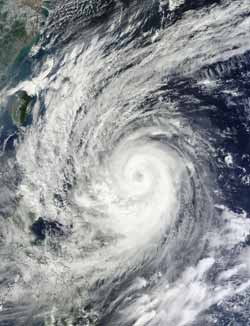

NASA's Terra satellite passed over Typhoon Prapiroon on Oct. 11 at 0210 UTC (1010 p.m. EDT, Oct. 10) and the Moderate Resolution Imaging Spectroradiometer (MODIS) instrument captured a visible image of the storm. The visible imagery clearly showed a small ragged eye, and microwave satellite imagery confirmed the eye. Satellite imagery also confirmed a well-defined low-level center of circulation.
By 11 a.m. EDT on Oct. 11, Prapiroon's maximum sustained winds were near 95 knots. It was located about 415 nautical miles south of Kadena Air Base, Okinawa, Japan, near 19.4 North and 128.5 East and not moving.
The storm slowed to a quasi-stationary position between two ridges (elongated areas) of high pressure. Prapiroon is expected to get a jump start again and get most of its steering influenced by the ridge located the east of the storm.
According to the forecasters at the Joint Typhoon Warning Center, between [12 and 24 hours from 11 a.m. EDT on Oct 11] Prapiroon is expected to Slowly re-curve around the western extent of the subtropical ridge and take on a northeastward track over the next three days.
Text credit: Rob Gutro
NASA's Goddard Space Flight Center, Greenbelt, Md.












